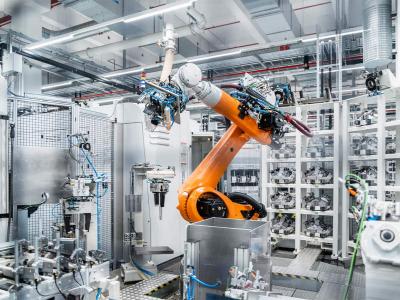Key takeaways
In today's global business landscape, the drive for integration of Environmental, Social, and Governance (ESG) frameworks within corporate strategies has become a necessity in building a sustainable future. From a business perspective, it plays a role in helping businesses to remain competitive or to attract new talent or retain customers and clients. Across Europe, companies are navigating the terrain of sustainability, seeking to balance profitability with responsible business practices.
In this fourth and final instalment of our manufacturing in Europe series, RSM’s specialists in Europe delve into how manufacturing companies are embracing this shift, the benefits they are reaping, and the challenges they are encountering along the way.
Prioritising ESG: Where do European manufacturers stand?
As with many businesses across various sectors, manufacturers are broaching the topic of ESG, but how far are they along their ESG journey? Well, it depends on the size of the organisation. According to Raffaele Mazzeo, Partner & ESG Leader at RSM Società di Revisione e Organizzazione Contabile S.p.A., "The situation is different between large companies and the mid-sized ones. Large manufacturing companies have already started integrating ESG considerations into their investment strategies through sustainable investments and interventions on ESG issues internally, with involvement across all company functions. Mid-size companies have, generally speaking, concluded the initial awareness phase."
Mazzeo continues: “Now mid-size companies are conscious of the relevance of ESG factors as an essential requirement to participate in value chains and are starting project sites that comply with the Corporate Sustainability Reporting Directive (CSRD). Italian companies also do their financial funding mainly through the banking channel. Against this backdrop, banks have given companies a strong push towards sustainability, as they have made large-scale requests to manufacturing companies for Capex, Opex and Turnover Taxonomy aligned share. The Italian manufacturing sector has fired up its engines toward 2050.”
Much the same is happening in Germany: “The implementation of ESG frameworks in the corporate strategies of mid-cap companies is currently slow because management is still dealing with the effects of the various crises of the last 2-3 years and the necessary transformations that followed,” says Götz Brinkmann, Principal at RSM Ebner Stolz. He continues: “ESG offers a variety of opportunities to align the business model for the future, especially in the medium and long term. Companies that have not yet taken ESG into account will come under increasing pressure as clients begin to demand ESG compliance. Therefore, short-term actions such as reporting and reducing carbon footprints, using circular economy systems, or respecting human rights are necessary. In addition, ESG aspects such as resource-efficient materials, sourcing and production processes can be integrated into product development.”
The UK, however, is seemingly breaking the mould, according to Mike Thornton, Partner and Head of Manufacturing at RSM UK. “In the UK,” he says, “many of our manufacturing clients are actively integrating ESG frameworks into their strategies, with the majority of attention so far focussing on becoming more sustainable. This shift involves aligning operations with sustainable practices, such as carbon footprint reduction, circular economy adoption, and ethical supply chain management. Of course, the social and governance aspects are also hugely important with many assessing labour practices, employee wellbeing, diversity and inclusion metrics and other governance policies.”
Despite long-term benefits such as enhanced brand reputation, increased attractiveness to conscious investors, and long-term cost savings through resource efficiency, challenges remain. "Current barriers include unclear requirements for compliance, expertise and investment," says Brinkmann. Not only this, but "Significant investment costs are often initially needed, and ensuring compliance across complex supply chains can be much easier said than done," adds Thornton.
Balancing cost-efficiency and sustainability
As Thornton already mentioned, one of the most significant challenges for manufacturers in the middle market in adopting ESG strategies and practices is the initial investment costs – but there is also the question of long-term costs. Manufacturers also face the formidable challenge of reconciling cost-efficiency with sustainability goals. However, the dichotomy between the two is not impossible; in many cases, the two are not mutually exclusive. By embracing sustainability principles, businesses can unlock many opportunities while mitigating risks associated with inaction.
"In recent years in Italy, several strategic manufacturing sectors, which in past decades had suffered from competition from low-cost countries, are showing significant growth, particularly among companies demonstrating structured sustainability governance," says Pierpaolo Pagliarini, Associate Partner at RSM Società di Revisione e Organizzazione Contabile S.p.A.. He continues: "Many Italian companies have realised that ESG involves recurring costs to ensure effective governance internally and on their supply chain; on the other hand, sustainable investments have strengthened the positioning of Italian companies in their supply chain. In general, these investments relate to, for example, improving and monitoring quality, environmental impacts, safety, employee relations, and anti-corruption."
However, as Pagliarini adds, “These higher expenses can be offset by higher revenues from certified products, such as in the case of EPD, Environmental Product Declaration, which requires LCA analysis. Another positive impact of sustainability on corporate cash flows comes from the increased availability of government subsidies and bank financing reserved for green investments.”
Brinkmann suggests that resource conservation and sustainability are not necessarily antithetical to cost-effectiveness: “It is possible to assess both requirements for the production network when planning the footprint and supply chains. The materials and production processes used are determined during product development. Alternatives can already be considered and optimised from a sustainability perspective, including cost aspects. The evaluation of an existing supply chain or sourcing, production and distribution network can also be subject to this consideration and, for example, be geared towards a situational shift towards local content to avoid logistics-related emissions and to produce and source more cost-effectively.”
Brinkmann continues: "The possibilities offered by Industry 4.0 technologies, such as the intelligent use of energy and resources; simulations to optimise the supply chain in terms of cost and sustainability; and the use of AI in the planning and control of sales, production volumes and procurement, can resolve the perceived conflict of objectives between cost efficiency and sustainability."
“The real task for manufacturers,” suggests Thornton, “is to get a proper understanding of the opportunities that becoming a more sustainable business brings, coupled with the business risks of being apathetic to ESG adoption. To do this, it is imperative that within internal return-on-investment models (alongside the normal parameters), manufacturers start to include more dynamic models that account for longer/lower rates of finance (as opposed to standard at that time), the potential increased market access that being a more sustainable business can bring, as well as the internal carbon cost savings.”
Ensuring that sustainability principles are embedded into business strategies and operations will also continue to be paramount, which comes with many crucial considerations for manufacturers. "These include considering stakeholder interest and influence, evaluating supply chain sustainability, conducting risk assessments across the short, medium and long-term; redefining internal processes (e.g. new product development and capital allocation); putting in place transparent reporting and KPIs; and assessing future skill requirements," Thornton adds.
Manufacturing a greener future
The journey towards sustainable manufacturing is multifaceted, marked by diverse approaches and regional nuances. While mid-sized companies are generally just starting out on their ESG journeys, the importance of sustainable strategies and practices is felt across the sector.
While the costs of adoption may prove a challenge to justify in the initial stages, manufacturers stand to reap long-term benefits that outweigh the challenges. In addition to the multiple benefits, as the global economy marches towards a greener horizon, the imperative for manufacturers is clear: embrace sustainability not as an obligation but as a pathway to enduring success, competitiveness, and responsible stewardship of our planet.
For more information on manufacturing or how RSM can help your business, please visit our Manufacturing page.
Contributors
If you missed the first three articles in this series, be sure to find them on our Manufacturing page or by following the links below:
Contact us
If you have any questions or concerns related to ESG and the impact on manufacturing, please contact our Global ESG services team.








